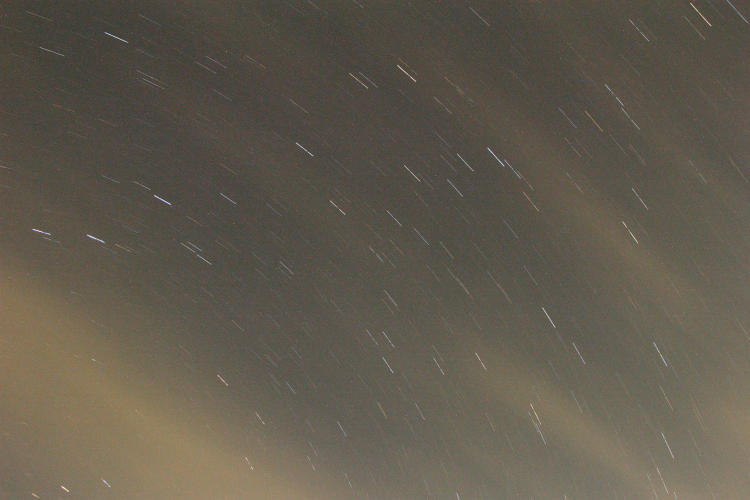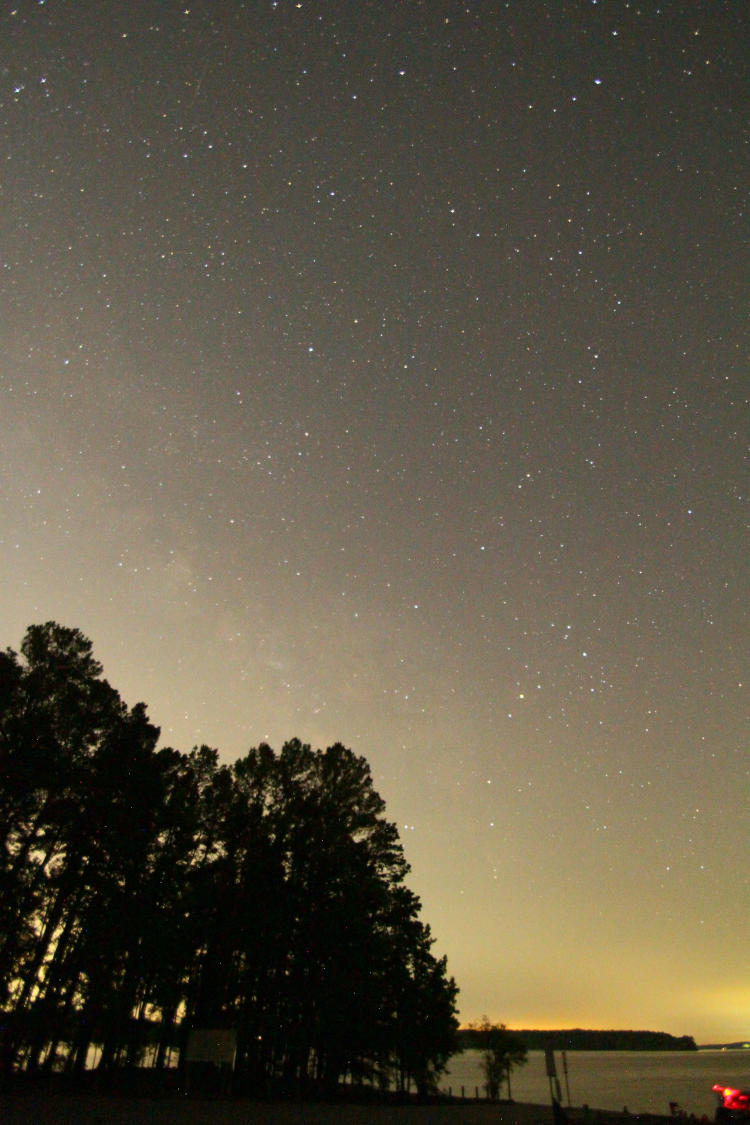
I did indeed get out early this morning to chase the Tau Herculids meteor shower, and I have to admit it was one of the better nights for it. Initially, scattered clouds obscured small portions of the sky as glimpsed above, but they cleared within the first half-hour of observing, while the temperature remained a lovely 20°c with a light breeze eventually stirring. The humidity remained high, however, which reduced visibility slightly, mostly near the horizon, and scattered the nearby city lights more than on the last attempt. This meant that long exposures got more of a background light than before.
Notably, I saw several meteors, the most I’ve seen since the 2001 Leonids while not being anywhere near that number. Essentially, I was seeing at least one for every ten minute time exposure I was shooting, and given my field of view, I was estimating the ‘whole sky’ number at about 15-20 per hour, which is roughly the same as reported by EarthSky.com – this meant that, sitting and watching carefully, you were almost guaranteed to see at least one, but probably more, and my count was roughly a dozen. I say, “roughly,” because some of those were ‘corner of the eye’ that I couldn’t feel confident of, and the fireflies were active this morning so a glimpse might only have been of one of those. More on that in a second.
All that said, I did finally catch a meteor, after decades of trying.

Yeah, Excitement City, huh? And after I just said that I saw a dozen or so. But there’s only so wide the camera lens will capture (even in this case, at 10mm,) and most of those that I saw fell outside the field of view at any given time. But we’ll go in a little closer on that same frame.

The meteor is the brighter streak – the dashed line is a firefly, and I watched it cut across in front of the camera. I had set ISO at 800 this time, and I’m not impressed; the noise/grain seems higher than even the very high ISOs for the Canon 7D.
You might have noticed, on the full-frame version, that the curved star trails reversed: this is because the plane of the ecliptic, essentially the line even with Earth’s equator, cuts right through the center of the frame, so the stars are describing arcs around the north pole above it, and the south pole below it, or at least the rotation of the Earth makes it seem that way in the time exposure.
There were a few others that I caught as well – or at least, may have caught. None of them have corresponded to any known satellites that I’ve found.

This is perhaps the most questionable one, because of the color speckling (which is most likely caused by the camera, and not the true color of the passing whatsit.) Either way, it was very dim, and not noticed by me as I was gazing around during the exposure.
This next one was curious, in that I was only after the Milky Way for this shot and so it’s only an 18-second exposure.

It’s up there at the top left of the frame, the barest little scratch. Here’s a close crop:

Bear in mind that 10mm focal length makes everything smaller, so visibly this would have been longer in the sky, but at least it has the tapered effect typical of meteors, brightening and dimming as it passes.
But those brighter stars? Yeah, I’m putting this down to the aspherical nature of the Tamron 10-24mm lens on stars near the edge of the frame, especially since the ‘wings’ face the opposite direction in the other corner, and vanish in the middle.
I had another trace one, but just confirmed that it’s a satellite, because it shows up in the previous frame too – I knew that was gonna happen. So while we’re here, we’ll take a quick peek at another frame obtained not long before I wrapped up for the night/morning.

I needed to try the Milky Way again while I was out there, and boosted the ISO to 6400 to keep the exposure short – I’d switched back to the Canon 18-135 at f4. The humidity is undoubtedly playing a role here, but the Milky way remains faint, no matter where you are, so there’s only so much that can be brought out. With real photography, anyway.
Then I tweaked it.

This is how it might appear (or much, much worse) if you saw it on Astronomy Picture of the Day, or what I’ve taken to calling the Photoshop Job of the Day, since virtually nothing that they feature any more involves an original photo. Image stacking, compositing, filters, enhancements, and all sorts of dicking around are used anymore, so the impression that you get from their photos rarely, if ever, represents what you might see or capture normally; it’s like the most heavy-handed of Twitter accounts. I understand this from a working astronomer’s standpoint, in that filtering for infra-red or hydrogen-alpha can reveal more details about nebulae and star formation, but for the scenic/artistic images, especially showing some kind of landscape – fuck it, you might as well just paint whatever you like in there.
Yes, I’m venting, and I’m aware that there remain a few tricks to produce better results, like being in truly dark, dry sky areas and using tracking motors, and at some point I’ll be attempting those. But a tracking motor will blur out landscape details in the same manner as the star trails up there, and I don’t care how dry the air is, it’s still air and will diffuse the light coming through it. But one of these days I’ll do such shots at the beach, at least getting away from the city lights, and we’ll see what happens.



















































